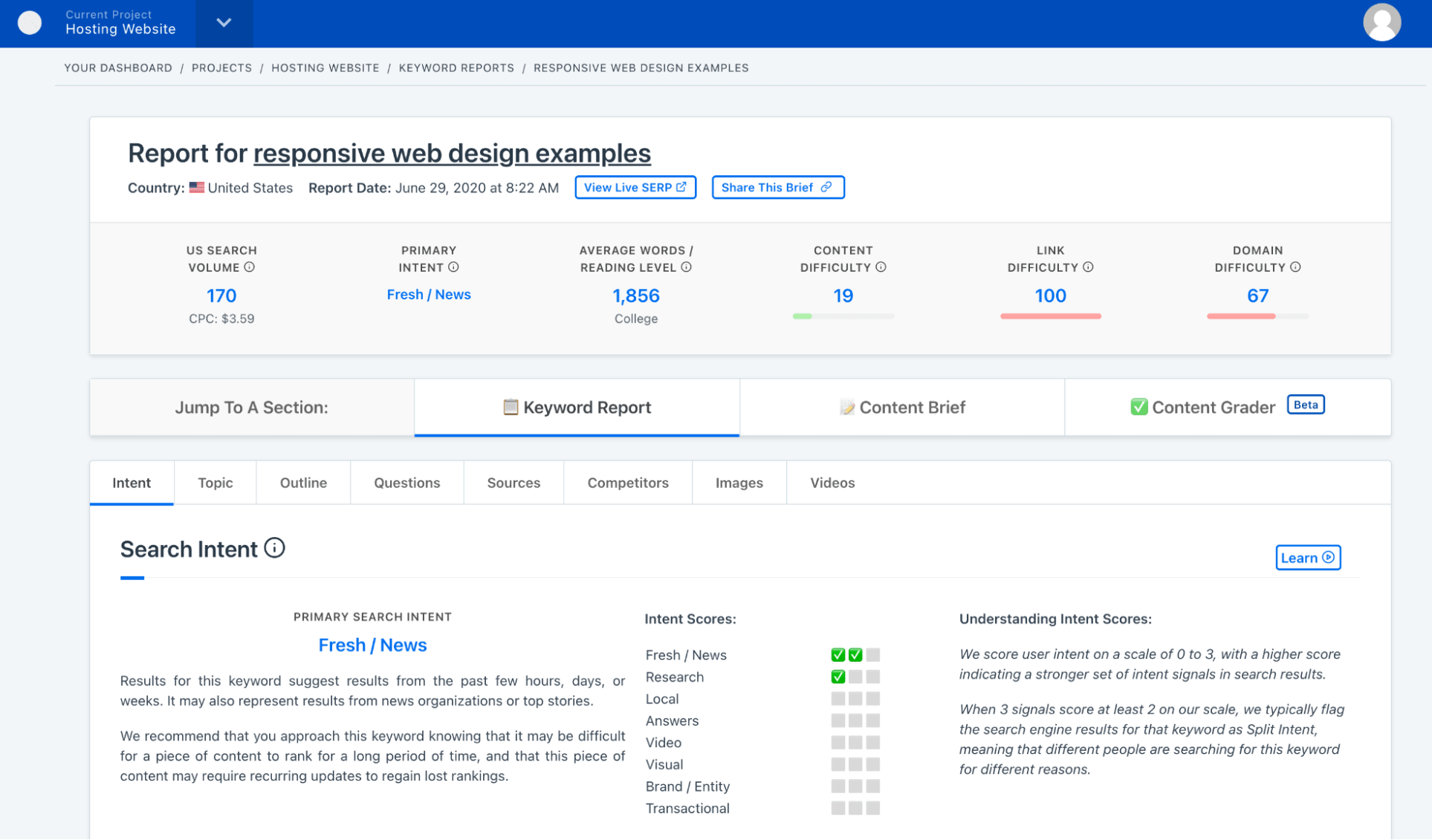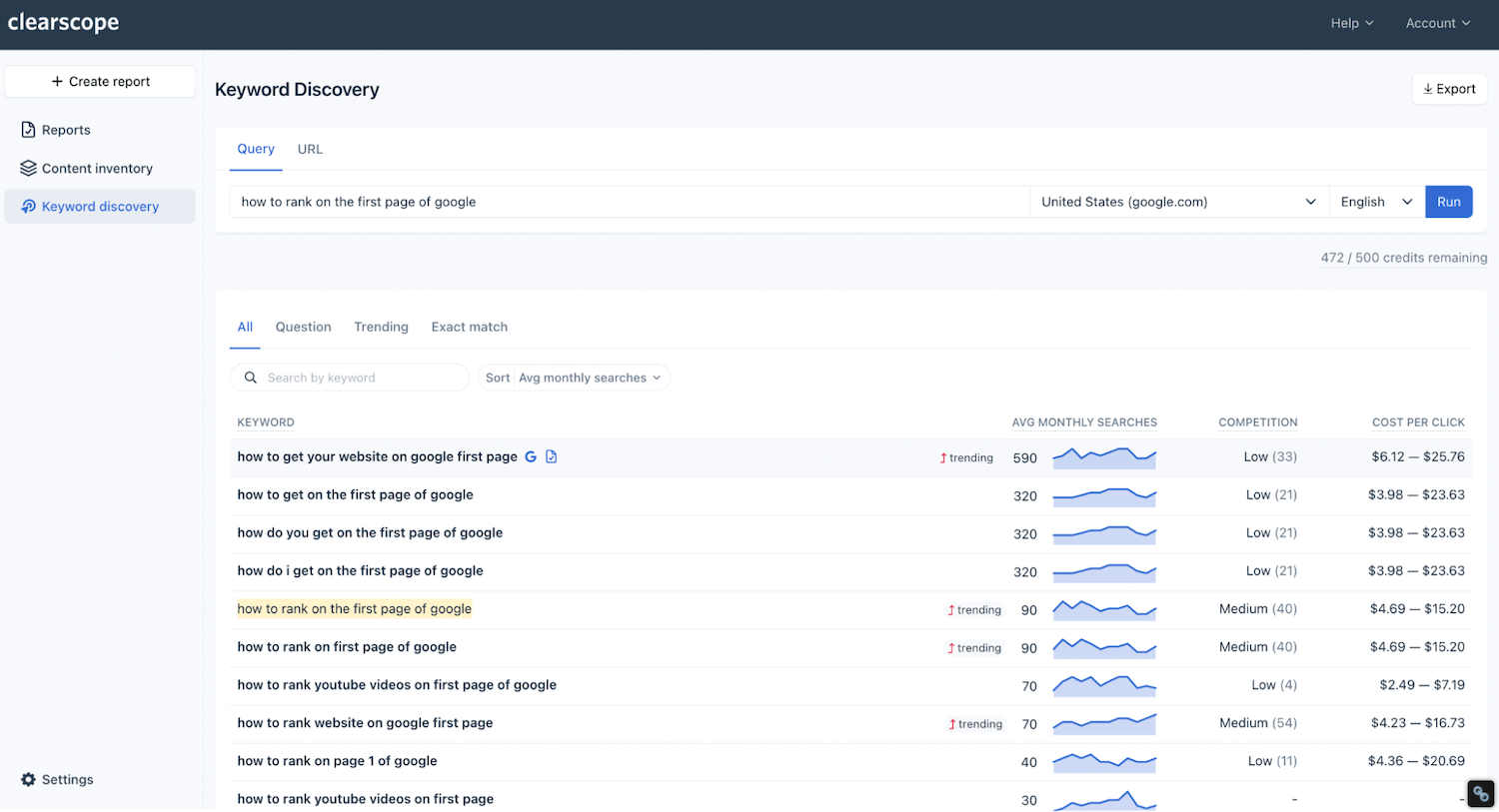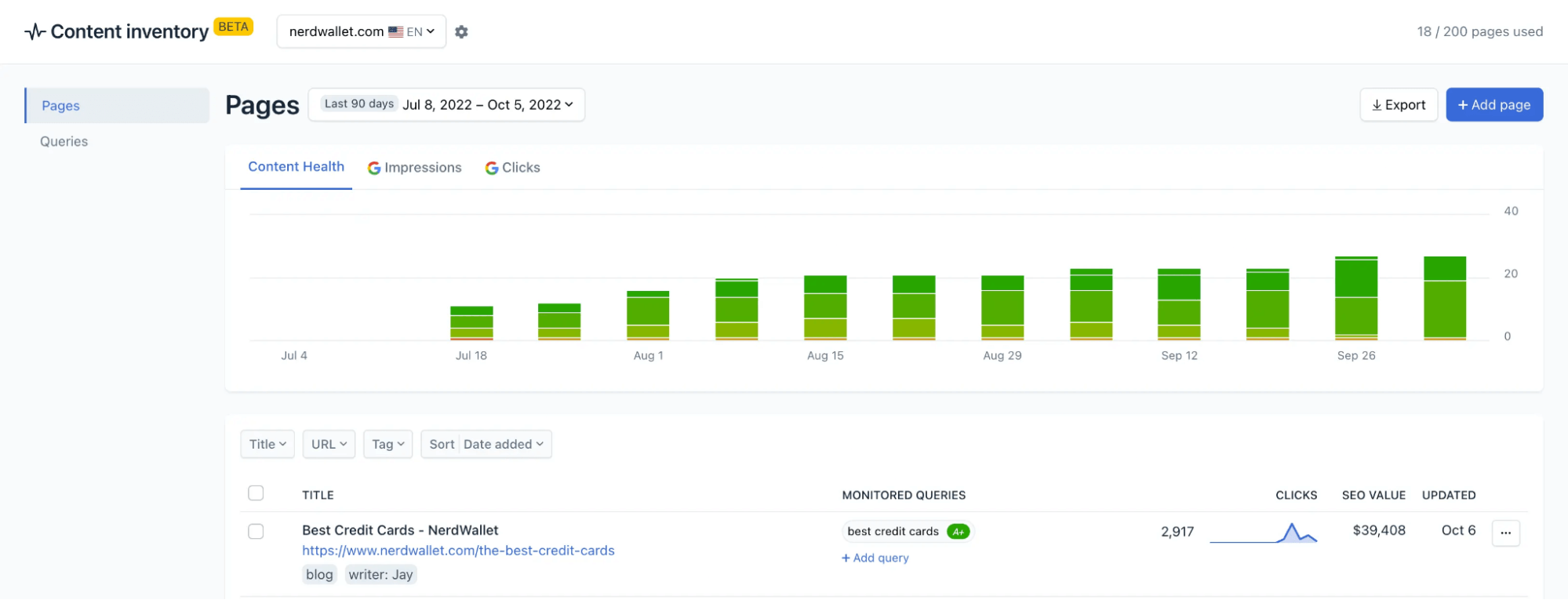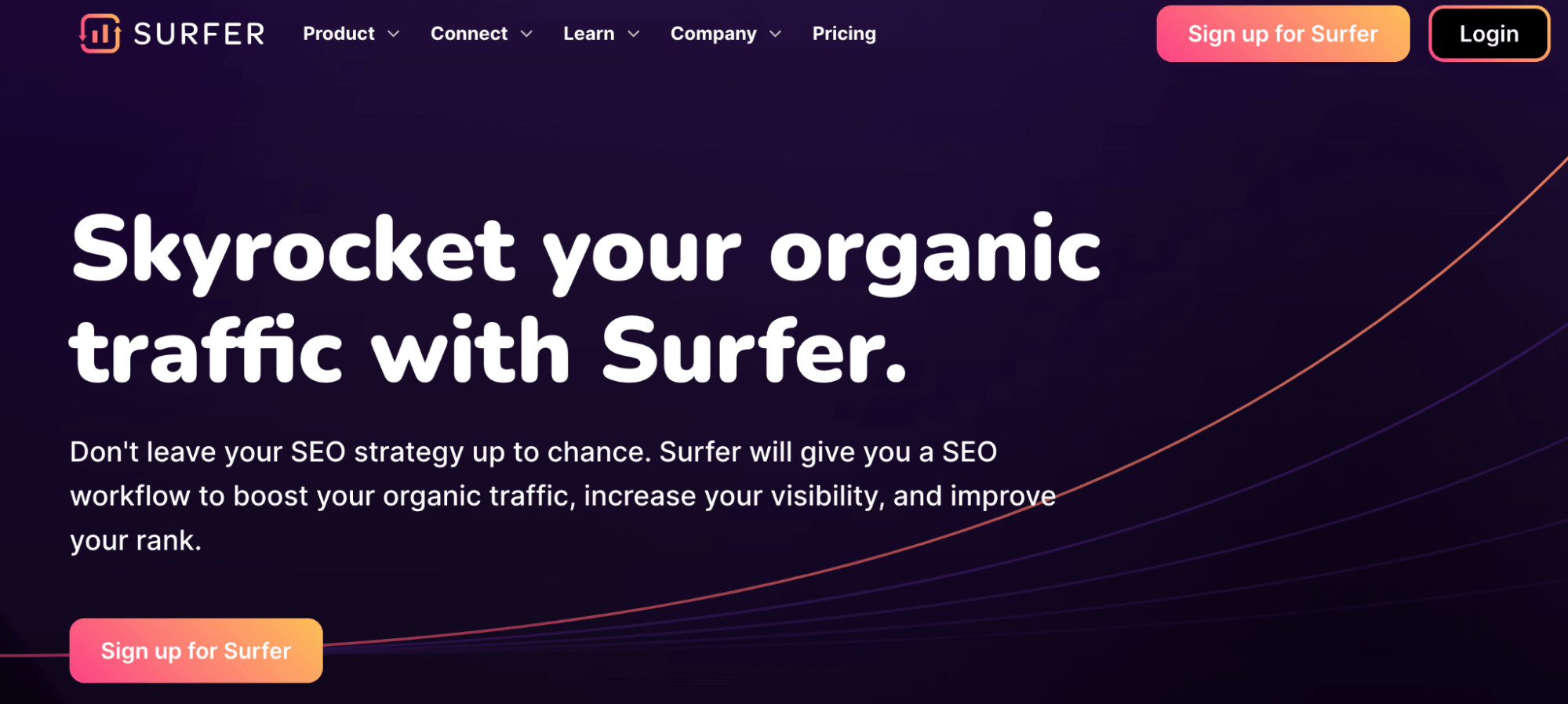
Table of Contents
Join our newsletter
Get access to trusted SEO education from the industry's best and brightest.
Our guide reviews five of the most popular Content Harmony alternatives — including our content optimization platform, Clearscope. We start with a quick overview of Content Harmony in case you’re still weighing it as an option.
If you’re interested in seeing how Clearscope compares (and can help you streamline all stages of content creation), you can explore our platform and packages or schedule a free demo with us. We offer starter plans and custom packages to support all content teams.
Content Harmony: Takeaways from user reviews
Content Harmony’s content optimization platform has features to automate SERP analysis and help writers identify search intent, build content briefs, and create SEO-friendly content. The tool is generally pretty easy to use: you plug in the target keyword, and Content Harmony generates a report where you can toggle between the keyword insights, brief builder, and content editor.
Reviewers praise Content Harmony for its keyword insights (like the search intent classification system) and brief builder — these tools streamline the topic research process so you can quickly understand what searchers are looking for and what Google is already ranking.
From there, you can determine your positioning and create the content brief from suggested outlines. This solution is especially popular amongst content managers who are tasked with assigning content to writers and freelancers.

However, there are a couple of issues we commonly hear about Content Harmony — and if you’re doing this research, you may be aware of them, too.
Specifically, Content Harmony isn’t all that time-saving for content writers. The brief builder may help content managers assign out topics more efficiently, but…
The reports and search intent analysis offer high-level takeaways from the SERP (which aren’t enough for writers to get the full picture and move forward) and then more or less pull all SERP data into Content Harmony. Writers can compare competitor outlines, review SERP features, and see questions from “People Also Ask” — but instead of viewing this content in Google, they’re viewing it in Content Harmony. But it’s still the same SERP analysis.
Content Harmony has fun features like AI-suggested questions and drag-and-drop outline builders — so you can create content from competitor outlines — but unless you’re copying these headings and FAQs word for word, they still require editing from your team. And if your goal is to produce unique content, these insights only get you so far.
Some of the information isn’t really necessary or all that helpful. Sure, you can see competitor content metrics like readability grades and word count, but most teams aren’t basing content strategies on this data. In most cases, teams want to write topical content that ranks in the top positions on Google, so the actual content creation (and not the readability grade of competitor content) is the primary focus. Which takes us to our next point…
The platform’s content editor and SEO reports aren’t very zoomed in — they contain hundreds of term recommendations (oftentimes repetitive terms and long phrases), and using each recommendation in content can add a lot of time to the writing process. So even if Content Harmony does save time on topic research, writing can be challenging, and it’s usually a zero time savings by the end of the process.
Compared to other content optimization tools, Content Harmony is lacking in features.
In addition to the types of features Content Harmony provides, most competitors (like us and the others mentioned in this guide) include helpful extras like keyword research tools, content inventory systems, or in some cases, AI writers. So instead of using and paying for multiple systems, you can manage content development in one solution.
Now, let’s talk about the top alternatives.
1. Clearscope
Content optimization to support & streamline SEO writing

Clearscope is one of the most popular content optimization platforms because we include features to support content managers and writers, and we have packages for all professionals and team sizes. (We can meet with you before onboarding to determine the best package and show you how the platform works.)
Our features include:
Keyword Discovery — so content managers can research keyword opportunities and build out content plans. We also show related opportunities when you search so you can find secondary keywords and create topic clusters.
Content Briefs — save a library of content brief templates to access and fill in for new topics. Then, users can share briefs within Clearscope reports or send writers the link to reference.
SEO Reports — these guide outlining and content writing; they include key takeaways from the SERP (instead of every detail), competitor outlines, heading suggestions, and a (condensed) list of terms to use in content.
Content Inventory — content managers can track SEO scores for published content to determine the competitiveness of each web page and schedule updates.
Our platform is easy to learn, but we also offer online training tutorials and free support — plus, our SEO reports are super user-friendly because they hone in on what’s important from SERP analysis and provide clear, focused recommendations. Writers can easily follow recommendations to produce SEO-friendly content within the context of their normal workflows.
Let’s review our core feature set.
Features
Keyword Discovery
Research keyword ideas and guide your content strategy.
Find and add topics to your content plan by searching keywords in Clearscope. You can research keywords in a few ways:
Look up specific keywords to see metrics like search volume, difficulty, and CPC.
Type in any word or phrase to see the related keyword opportunities.
Filter keyword options by trending topic or question — these can help you find long-tail or secondary keywords.

We provide quick links so you can explore SERPs and generate SEO reports; you can easily assess opportunities and create reports for the keywords you want to target. All reports are saved in your Clearscope dashboard so writers and managers can reference them as needed.
SEO Reports
Create top-ranking content with guided reports.
Let’s say we’re targeting the keyword “how to get on the first page of Google” — you can create an SEO report and access insights to position and build content.
Our reports include:
A research tab with information from the SERP — you can see themes, a list of searcher questions to answer, and authoritative resources to reference and cite within content.
Competitor outlines — identify trends between competitor content, see the exact content headings and format, and learn more about target audiences.
A list of headings and terms to use in content — we keep this list relatively short so writers don’t become preoccupied with “checking boxes,” and we have a semantic grouping feature to filter like terms and show writers how to cover relevant topics more easily.

The quality of our terms list is what differentiates us from competitors like Content Harmony (and a common reason why teams choose Clearscope). We primarily stick to single-term recommendations and use natural language processing (NLP) to detect variations of term suggestions. You can achieve competitive SEO scores without keyword stuffing or undercutting content quality.
We also have a dedicated page within reports where you can dig further into competitor content — this page is similar to Content Harmony, where you can view all URLs on the first page (we show positions #1–30) and each page’s title, SEO score, and word count. Then, you can click into competitor sites if you want to read more.
With these insights, you can determine positioning, construct your outline, and either (a) put together a content brief to save within reports and share with writers, or (b) begin writing content yourself.
Before we talk about briefs, let’s explain how content writing works in Clearscope.
Writers can either work directly in our text editor or use our Google Docs integration to access reports on that platform. Our reports update in real-time so you can track progress as you write: see the terms you’ve used, SEO score, readability grade, and word count. In addition to our semantic grouping feature, we also have options to filter by heading or “Unused” so you can change the view as you work.

Your teams, even writers without SEO experience, can produce optimized content without worrying about best practices, placing keywords in specific spots, keyword density, etc. Our features supplement your existing workflows to support natural, high-quality content.
Read more: SEO Writing: 5 Steps & Tools to Create Top-Ranking Content
Content Briefs
Assign content to writers and track progress in Clearscope.
The process of creating and sharing briefs with writers is straightforward — here’s how it works:
You can create a library of brief templates to store and access within Clearscope — most teams create templates for different content types (product review guides, “how to” guides, case studies, etc.). We even have a collection of pre-made templates that we can share with you during onboarding.
You can insert templates in reports to fill out the details and create a suggested outline.
You can share reports with writers so they can access the details and see the saved brief.

Unlike Content Harmony, we don’t have drag-and-drop features to create automatic outlines, but we disagree with those features because they lead to duplicate content (a.k.a. repeating what’s already been said).
In order to rank highly in search engines, you need to create unique content that appeals to search intent. So we show you what’s important, but it’s up to you to create something original from those insights.
Content Inventory
Stay on top of site content to see continual ROI from content marketing.
One of our newest features is Content Inventory — which is especially helpful for writers and managers who need to monitor a high volume of content. This dashboard lets you save all of your website pages with the target keyword(s) to track real-time SEO scores.

Our platform can show you precisely when content is starting to become “outdated” so you can make updates before rankings or organic traffic slip. It works by monitoring SERP changes, algorithm updates, and new competitor content, and performing content analysis on your web pages to show you how they compare.
With Clearscope, you don’t have to re-do this SERP research yourself, you simply check into the Content Inventory dashboard, see scores, and add pages to your content plan for updates.
When pages are due for a refresh, you can run a new SEO report and use our WordPress integration to edit content within the CMS.
You can add an unlimited number of URLs to this dashboard as your website content grows. We offer custom plans to ensure your package is tailored to what you need.
Read more: How to Create a Content Inventory & Perform a Content Audit
Packages & pricing
Every package includes access to all of the above features: Keyword Discovery, Content Briefs, SEO Reports, and Content Inventory. We have starter packages for small and growing teams, or you can request a custom plan, and we’ll create a package around your requirements. Packages start at $199, and you can choose a monthly or annual plan.
Get started in our platform here, or schedule a free demo with our team to explore our features and learn about packages.
2. MarketMuse

MarketMuse is another common Content Harmony alternative. Many teams prefer MarketMuse to Content Harmony because it has advanced keyword research tools (i.e., a feature Content Harmony doesn’t have) in addition to an automated brief builder and SEO reports. And most positive reviews of the platform specifically talk about MarketMuse’s content planning features.
Features
Let’s review MarketMuse features and explain their strengths and weaknesses.
Content Strategy Tools — this includes features to perform keyword research, prioritize topics, create topic clusters, and build a strong content plan. This is great for beginner SEOs who want to find the most valuable opportunities for their content plan and need tools to identify what those are and the best course of action per topic.
This is MarketMuse’s strongest feature.
Content Brief Builder — this is very similar to Content Harmony’s brief builder where you can access one of your saved briefs, fill in details, and create an outline from competitor content.
This saves content managers time and gives writers direction, but we take the same stance on drag-and-drop outline builders: you have to edit the content if you want to say something new.
Competitive Content Analysis — these reports have a similar structure to Content Harmony’s SEO reports, you can toggle between pages to view:
The “SERP X-ray” which tells you stats from top-ranking content like the average number of images or links per post and the high-level search intent (transactional, informational, navigational..).
A list of pages in organic search results where you can click to open competitor sites.
A “heat map” that shows SEO scores and terms used in competitor content.
We hear mixed reviews on this feature, as it’s not as helpful as MarketMuse makes it out to be. The SERP insights are helpful but extremely surface level (even more so than Content Harmony’s SERP insights), so you still have to perform SERP analysis yourself to get the full picture. Plus, the heatmap feature is mostly confusing: comparing competitor SEO scores is helpful, but trying to compare exact terms from post to post makes the writing process far more complicated than it needs to be.
SEO Reports — these include a list of headings and terms to use in content, and show your progress as you work. This guides the actual content writing process, so users can optimize content as they draft.
The feedback on MarketMuse reports is similar to what we hear with Content Harmony: the terms list contains hundreds of recommendations, many recommendations are long phrases that are difficult to weave in content, and achieving a competitive SEO score is hard without sounding keyword stuffy.
Overall, we’d recommend MarketMuse for SEOs that need extra help with content strategy and want a solution that includes keyword research tools.
Packages & pricing
MarketMuse offers a free plan (with access to 1 user seat and basic reports), a few starter plans, and custom plans, so they can accommodate various team sizes. However, they divvy up feature access and support offerings — for example, you have to choose the top tier plan to access Content Briefs — and if you choose a custom plan, they require an annual contract.
Teams can end up paying $399+ per month just to access all of the features they require from MarketMuse.
How to get started
MarketMuse has a slight learning curve but is generally easy to use. They also offer support packages for teams that need extra help.
You can get started in the free plan (but note you’re working with “limited” versions of reports) or sign up for a starter package. You can also contact their team for a demo to talk about custom plans.
Read more: Best MarketMuse Alternatives: Clearscope + 3 Runners Up
3. Surfer SEO

Surfer SEO is also a popular SEO tool for teams interested in content strategy — but beyond content planning, Surfer can help you manage existing site content. So, it’s recommended for large teams or teams with well-established sites because they can manage new content creation and keep tabs on previously published content.
They do not offer a dedicated Content Inventory, but they do monitor your site to deliver personalized SEO insights. For example, the Grow Flow dashboard can offer keyword suggestions, notify you if a page contains a broken link, suggest content updates, etc. You receive 10 tips each week, so you aren’t overwhelmed with recommendations.
We’ve heard mixed reviews on Grow Flow: sometimes those tips are really helpful, other times they aren’t, and sometimes they’re so technical you need an expert SEO to actually implement Surfer’s advice.
Let’s talk about the other features.
Features
In addition to the Grow Flow Dashboard, Surfer also offers:
Keyword Research — these are similar to MarketMuse where you can find keyword ideas, create clusters, and prioritize topics in your content plan. This feature can be a little tricky at first but is generally user-friendly.
SEO Reports — these display suggested headings and terms for writers to reference as they draft, like the other SEO reports we’ve talked about above.
Surfer does not get great reviews in this category, though: users say report recommendations are unclear, so you don’t know what to prioritize, and Surfer’s list of terms can include over 300 items, so you can spend hours trying to achieve a competitive SEO score.
Then, if you actually do appease Surfer reports, you usually have clunky content that sounds like it’s written for SEO. Experienced SEO writers can usually pluck what’s important from reports and draft content based on best judgment, but beginners may have more trouble.
AI Outline Generator — Surfer can analyze the SERP and competitor content to create outlines for you. However, we have similar hesitations with AI writing assistants as we do automatic outline generators; even if AI writers create a remixed version of what’s ranking in SERPs, they still don't have the capacity to produce unique (top-ranking) content, so we don’t recommend them.
AI Content Writer — if you don’t want to write content yourself, you can have Surfer’s AI writer fill in your outline. This can work for “filler” content, if you want to publish content on viral or common topics.
Packages & pricing
Negative reviews often mention Surfer’s packages and pricing because they’re not very budget- or user-friendly.
They offer two starter packages with access to keyword research tools and SEO reports, but if you want access to Grow Flow and the AI-powered add-ons, you have to start at a mid-level package ($249/month). Then, Surfer AI features are “pay as you go,” so you still have to pay $29 for every article you use AI functionality to outline or write.
They also offer enterprise and custom plans for large-scale teams.
All packages are billed annually.
How to get started
Out of the options we’ve covered thus far, Surfer is the most complicated to learn; that said, most users can learn the ins and outs without a ton of training. They also offer “Surfer Academy,” where you can access tutorials on the platform and its features.
You can get started by signing up for a plan or contacting Surfer for a demo.
4. Dashword

Dashword is the most direct competitor to Content Harmony because the platform has extremely similar offerings without a lot of extras (like keyword research or content strategy tools). Dashword is a go-to for small teams because the platform is pretty straightforward and easy to use, and they have affordable packages.
Features
Dashword offers three main features:
The automatic content brief builder — you plug in the target keyword, then Dashword analyzes the SERP to pull competitor outlines, FAQs, and terms to use in content. Then, you can add notes about the content angle/format and create an outline to kick writers off. This works in the same way as Content Harmony, where you can drag and drop competitor content to build outlines; it’s fast and easy, but not the best strategy.
SEO reports — these are also very similar to the reports mentioned in other tools. Writers receive a list of headings and terms to use in content and can track progress as they work.
The problem with these reports is that term suggestions are not super unique; there is a lot of overlap, and most terms are obvious variations of the primary keyword. You’re essentially stuffing the keyword all throughout content to achieve a competitive SEO score. That’s why many teams find Dashword to be a little too basic for strategic content creation.
Content monitoring — this feature is similar to Clearscope’s Content Inventory tool where you can track SEO scores for published content. You can save URLs to this dashboard and Dashword will notify you if content grades slip. Then you can slot content in for a refresh.
AI Writer — Dashword also includes an AI writing assistant for teams that want to take advantage of these tools.
Read more: Best Practices for Updating Website Content
Packages & pricing
Dashword offers two packages: Startup and Business.
Startup includes access to 5 user seats, the automated brief generator, SEO reports, and the AI writer. This plan costs $99/month.
Business includes access to everything in Startup (plus an increased number of SEO reports and AI writing words) and Dashword’s content monitoring dashboard. This plan costs $349/month.
They do not offer custom plans, and you’re locked into what Dashword offers per plan — so if you need fewer reports or user seats, you have to pay for reports/seats you aren’t using, and vice versa, if you require additional reports or more than 10 users, you’re limited to what Dashword lets you work with.
How to get started
You can get started in Dashword by signing up for a package, they offer your first report for free. As mentioned, the platform is easy enough for anybody to learn, but it may feel too beginner for more experienced SEO writers.
5. Frase

We’ve briefly mentioned AI writers throughout our post, but Frase is our Content Harmony alternative for teams that want to use these tools to produce high volumes of content. Frase’s selling point is that the platform can produce SEO content in minutes (vs. hours), so you can knock out topics on your content plan in a fraction of the time.
This tool can be helpful if you know how to use AI writers strategically — just remember: these tools aren’t helpful in all cases, and in most cases, we advise against them. So, if you’re interested in Frase, use the platform with caution. You really can’t expect AI to replace your content team.
Features
Frase offers:
An SEO Research tool — this lets you analyze SERP results, review competitor content, and build your content outline with these insights. Frase AI can also construct the outline for you.
AI Writer — this “fills in the gaps” after you complete the outline.
You basically enter your keyword into Frase, and the platform does the rest for you.
However, the feedback we hear on Frase is on par with other AI writing tools. It can analyze what others are saying about topics and create a new version, but it can’t say anything new, represent your brand, sell products, or provide personal advice, examples, or opinions. Plus, sometimes, the writing can be inaccurate, illogical, or hard to read.
Anything produced by an AI writer requires human intervention. You should review and edit — if not completely remix — content.
The idea of Frase, as mentioned, is to save teams time — and AI writers are time-saving when tasked with certain topics, but it’s also not uncommon for editors to spend hours turning AI content into something worth publishing.
In addition, Frase offers a content brief builder, SEO reports, and content scoring for teams that want to tackle content themselves. These work in very similar ways as the tools mentioned above. They also provide some features for content managers to organize reports in folders and share reports with writers.
Packages & pricing
Frase offers tiered packages for individuals, small businesses, and enterprise users.
Prices range from $14.99–114.99/month (plus an extra $35/month for AI features).
Pricing is based on user seats and number of articles per month, but it’s worth noting that the top-tier plan only accommodates three user seats (you have to pay an extra fee each month if you plan on adding extra seats).
They include full-feature access for every plan.
How to get started
You can get started in Frase by selecting a package — they charge only $1 for the first five days, so you can explore the platform and make sure you’re happy with it before your subscription starts.
Clearscope content optimization platform supports content managers and writers with features to guide each stage of content creation, from researching topics to tracking published content. The platform is easy to learn, and all of our users have access to our complete feature set. Our pricing is straightforward and we offer custom plans for teams with special requirements.
Get started here or contact us to learn more.



